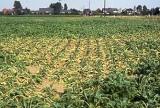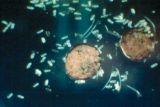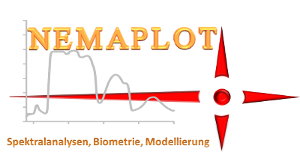Modeling and density estimation of Heterodera schachtii populations
Introduction




Population density estimations of the beet cyst nematode (BCN) Heterodera schachtii are extremely tedious in field situations. Not only taking soil samples and the preparation in the lab, but also counting under the microscope is simply a torture. In short, estimating the nematode population is cost intensive, defective and determined by a high variance due to spatial heterogeneity and some other factors. Coefficients of variation above 100% are common. The excessive variance includes a certain advantage: There are just few statistically certified facts, "trend" is the more realistic result. Most interesting, the nematode surprises every year, when new data are provided and speculations are in advance of hard evidences. The advantage, alternative views cannot be rejected that easily as it is normally done (nevertheless, it is done). This project illuminates facts about the beet cyst nematode from a different perspective, and is questioning and challenging widely accepted "certainties".
Publications about H. schachtii are plentiful, the life cycle is sufficiently known. Its dramatic impact during the 19th century on the local sugar industry echoes until today. BCN is a worldwide problem, parasites many hosts, as many of the plant parasitic nematodes do. Obvious symptoms are or has been clustered wilting symptoms, partly reversible, in sugar beet canopies, does not necessarily happens nowadays. A descent crop rotation is the most efficient way to control the nematode. Once in your field, you can't get rid of it anymore. Therefore the question about BCN is not an easy yes or no, but to keep the population under the economic threshold level (500 to 1000 E&J/100 ml soil). The potential thread of H. schachtii has been reported so often, with losses of 40% and more or fertility rates of 400 eggs/cyst. Such losses might have happened in earlier times, or measurements have been taken in the middle of the clusters. No doubt, the BCN can cause severe damage to a sugar beet (top, center fig.). On average the situation is much less dramatic, the fertility rate with mean eggs/cyst are in the range of 40, and crop losses are more in the range of 5-7% than above. Nevertheless, the impact of BCN must not be underestimated, as the nematode has synergistic effects on much more severe diseases (i.e. Rhizoctonia). The nematode corresponds specific to the type and length of the chosen crop rotation. A wide rotation is the suitable choice for BCN control, but it is difficult to handle, as the economic pressure forces the application of tight rotations.
Taking the numbers of publications of the last 20 years as measure of importance, BCN is not of major concern anymore. The use of tolerant and resistant sugar beet varieties and the long term use of resistant intercropping species reduced the nematode population to a manageable size even in 50% sugar beet rotations. This comfortable situation might not stay as it is. We will show some points of serious concerns in this project related to the climate change discussion.
The targeted unit of this project in terms of population density estimation is "E&J/100 ml soil" before planting sugar beets date (this date is somewhat traditional as it bases on the classical soil fumigation/nematizide application), but other points within the season might be of similar interest. The objective of this project is the reduction of the cost intensive and error sticking soil samples. We test the possibilities on different scales by taking into account certain key characteristics of BCN. Parts of the characteristics are:
- density dependent development
- significant temperature dependency of development and reproduction
- massive interaction with the host dynamics
- several generations per season
- spatial heterogeneity
- system specific equilibrium densities, ie. any measure results in stable conditions with time.
 Evaluation reinvented
Evaluation reinvented